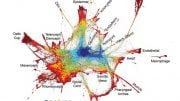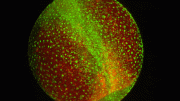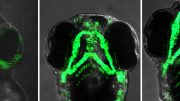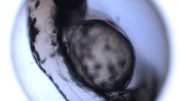
Researchers discovered that heart cells begin to beat suddenly and simultaneously as calcium levels and electrical signals rise. Each heart cell can beat independently without needing a pacemaker, and the heartbeat initiation can occur at various locations within the heart.
Researchers find that heart cells in developing zebrafish begin to beat abruptly and all at once.
Transforming from just a few cells into a fully developed organism, equipped with working tissues and organs, is a chaotic yet highly synchronized process that requires cells to organize themselves in a precise manner and begin working together.
This process is especially dramatic in the heart, where static cells must start beating in perfect unison.
Now, a cross-school collaboration led by researchers at Harvard Medical School and Harvard University has provided a glimpse into exactly how cells in the heart start beating.
In a study conducted in zebrafish, the team discovered that heart cells start beating suddenly and all at once as calcium levels and electrical signals increase. Moreover, each heart cell has the ability to beat on its own, without a pacemaker, and the heartbeat can start in different places, the researchers discovered. The findings were recently published in the journal Nature.
“People place such importance on the heartbeating that it’s been a focal point of investigations for a long time, but this is the first time we’ve been able to look at it in depth with so much resolution,” said co-senior author Sean Megason, professor of systems biology in the Blavatnik Institute at HMS.
Learning about the fundamental mechanisms underlying the heartbeat may be inherently interesting for the curious biologist, but it is also critical for understanding what is happening in situations where the cardiac system that regulates the heartbeat doesn’t develop properly, or begins to malfunction.
“The heart beats about 3 billion times in a typical human lifetime, and it must never take a break,” said co-senior author Adam Cohen, professor of chemistry and chemical biology and of physics at Harvard. “We wanted to see how this incredible machine first turns on.”
Straight to the heart
The researchers didn’t set out to study how the heart starts beating. Rather, they were casting about for a scientific question that would combine the Cohen lab’s expertise in imaging electrical activity with the Megason lab’s interest in studying how cells in developing zebrafish learn to communicate and cooperate.
Their search led them straight to the heart.
They realized that despite millennia of research on the developing heart, stretching all the way back to Aristotle’s observations in chicks, the details of how heart cells start beating were still a mystery — one that they could potentially solve.
“We wanted to answer a basic question: How do heart cells go from silent to beating?” Megason explained. “When your heart starts is a once-in-a-lifetime event, but it’s not obvious how that happens.”
This was an exploratory study, the researchers noted, so they didn’t know what they would find out. Maybe a few cells would start beating, and the beating area would slowly grow, they speculated, or different parts of the heart would start beating independently and eventually merge, or the heart would start with weak beats that would strengthen over time.
As it turns out, the answer was none of the above.
Using fluorescent proteins and high-speed microscope imaging, the researchers captured changes in calcium levels and electrical activity in the heart cells of developing zebrafish embryos. To their surprise, they discovered that all the heart cells abruptly transitioned from not beating to beating — characterized by simultaneous spikes in calcium and electrical signals — and immediately began beating in sync.
“It was like somebody had flipped on a switch,” Cohen described.
Further experiments revealed that for each heartbeat, one region of the heart fires first, initiating a wave of electricity that rapidly flows through the rest of the cells and prompts them to fire.
Interestingly, the heartbeats started from different spots in different zebrafish, suggesting that there’s nothing unique about the cells that fire first. This finding was counterintuitive because cells in adult hearts behave differently.
“Unlike the adult heart, where a specialized population of pacemaker cells drives the heartbeat, most cells in the embryonic heart have the ability to beat on their own, making it difficult to predict the location of the first beats,” said lead author Bill Jia, a joint graduate student in the Cohen and Megason labs.
Because the heart cells start beating instantaneously, they must develop the ability to beat and sense their neighbors’ beating before their very first heartbeat — something Megason compares to an army that has to start marching in sync without practicing first.
“The heart first learns how to keep pace without a clock, and individual cells first learn to cooperate without agreeing on what their roles are,” Jia added. “It is very important for the heartbeat to be regular, but it is organized very quickly at the start of life from what seems to be a total mess.”
Developing zebrafish offers a convenient model for studying the heart because they are transparent, grow quickly — developing a heartbeat in only 24 hours — and can be imaged by the dozen. However, Megason thinks the same developmental process may be conserved across species, including humans.
This finding, the team noted, opens the door to learning more about the development of heartbeat across species, and may one day illuminate how cardiac irregularities such as arrhythmias arise in humans.
“By looking at how the heart develops, we can see how different control mechanisms are layered on, which may tell us something about what happens if they break down,” Megason said.
Reference: “A bioelectrical phase transition patterns the first vertebrate heartbeats” by Bill Z. Jia, Yitong Qi, J. David Wong-Campos, Sean G. Megason and Adam E. Cohen, 27 September 2023, Nature.
DOI: 10.1038/s41586-023-06561-z
This work was supported by the Howard Hughes Medical Institute, a Vannevar Bush Faculty Fellowship, and the HMS John S. LaDue Fellowship in cardiovascular medicine.









Be the first to comment on "New Harvard Research Reveals How the Heart Starts Beating"